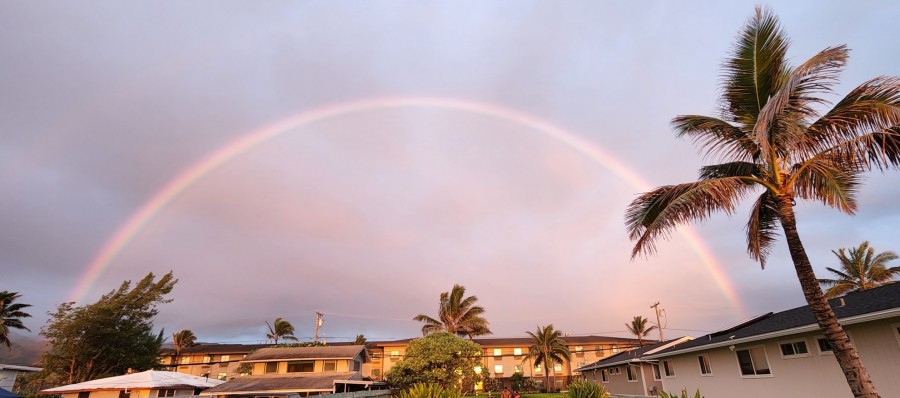Traveling, even if it’s to the same ole place you always go to kick back, can be educational. But going somewhere new is even more so. Case in point is our trip to Oahu. Not our normal destination. As such, it was educational in many ways. Some expected. Others not.
The expected included beautiful beaches with clear water. We found plenty of hiking trails and enjoyed several. It is a place where even if you don’t do anything but sit on the beach all day, you still feel like you’ve done something worth your while. Especially if you are on the western side of the island at sunset.
One hike I highly recommend is Diamond Head. This crater was formed by a rather violent volcanic explosion some 150-thousand years ago according to the park sign. The hike is a bit strenuous, but there are places along the switch back trail to rest and refresh with the bottle of water you hopefully brought with you. But the payoff at the top and along the trail itself is worth it. Upon completing the hike and heading for the parking lot, a mother and her daughter were headed to the trail. The girl couldn’t have been more than eleven or twelve. As we approached, I heard her ask her mother, “Mom when will I be old enough to have a boyfriend?” Without missing a beat as we passed I replied, “When you’re 42.” Over my shoulder I heard the mom say, “That’s right!” We parents of daughters have to stick together.
Being a numbers nerd, I took time to check on some stats. I learned that Oahu is the third largest of the five major Hawaiian Islands. It is about 44 miles long and 30 miles wide and is the most populated of the five. I say five major islands because the city and of Honolulu actually includes 132 islands and islets northwest of Kauai. Apparently volcanic islands and islets are like rabbits left to their own devices. They just keep creatin’ and a creatin’.
Oahu and the rest of the chain is also notable for what it doesn’t have. There are no snakes, mosquitos, or rabies. You also will not find hummingbirds. They would cross pollinate the pineapples causing unwanted seeds in the fruit.
What you will find are mongooses or mongeese if you prefer. Either is acceptable as the plural. I checked. Although I don’t know why you can’t refer to a group of mongooses simply as mongoose in the same way that one deer and a herd of those garden munchers are both called “deer”. As far as the mongooses themselves, I couldn’t tell you if they are acceptable or not. I think of them more as Hawaiian squirrels. Nonetheless, how they got there is an interesting story.
The mongooses are there because of the rats. The rats are there because they hitched a ride with early settlers likely from both the South Pacific and Europe. Seems that the rats were, and still are, doing a number on the crops grown there to the tune of millions of dollars a year. Now you could spend your time hunting rats or you could bring in a natural predator to fight them.
Enter the mongoose, which is where this story gets a bit sticky. For those who have read Rudyard Kipling’s story “Rikki-Tikki-Tavi” or seen the animated movie based on it, you may think that a mongoose only eats snakes. Actually, they will eat almost anything including rats. Sounds like the mongoose would be the perfect solution to the rat problem. Well, yes and no. Had the people who tried to solve the rat problem had had the advantage of Googling, they would have found that rats tend to be nocturnal. Mongooses are not. Working different shifts, they rarely meet. Problem unsolved. Happens sometimes when man plays God.
One thing I learned through observation is why the University of Hawaii goes by the nickname “Rainbow Warriors.” One day on any of the islands will tell you why. Given the almost daily brief showers, Hawaii has more rainbows in a week than you’ll find in a jumbo box of Lucky Charms. Granted you can’t eat them, but they are much bigger and more beautiful than words can describe.
Also among the unexpected were the number of chickens roaming the wilds of Oahu’s north shore. When we arrived at my son’s abode after two long flights, one layover and an hour-long drive on both ends, we were greeted by the sound roosters crowing. I knew there would be some interesting birds on the islands, but I really expected more exotic birdsong than “cock-a-doodle-doo!”
“Who owns the chickens,” I asked my son.
“No one,” he replied. “They’re feral.”
Feral chickens? Really? Wow, “free range” in the truest sense! And they are almost everywhere. Go to any eatery with outdoor seating and you’ll likely find them on the menu and wandering among the tables.
At one café in Haleiwa, the manager was chasing them out of the dining area with a Super Soaker water gun. Great entertainment. Oddly enough, we didn’t encounter such a floor show or any puttering poultry among the diners at Turtle Bay Resort. Guess they have bigger water guns elsewhere on the property.
I am glad to report that our local patriarchs of poultry will be glad to know that, although our daughter no longer lives in the poultry capitol of the world, she still has that Gainesville perspective when it comes to our fine feathered friends. This was evidenced by her remark upon seeing some baby chicks walking across a parking lot.
“Look Dad, nuggets.”
That’s my girl!

http://accesswdun.com/article/2022/7/1120204/oahu-101
